Analyzing Australian Healthcare Reform: Medicare's Impact & Future
VerifiedAdded on 2023/06/03
|11
|3012
|471
Report
AI Summary
This report provides a detailed analysis of the Australian healthcare reform, focusing on changes to Medicare and its impact on the healthcare system. It discusses the objectives of the reform, including expanding healthcare coverage and reducing medical costs. The report critically evaluates the strategies employed, highlighting both the benefits, such as increased access to healthcare services, and the loopholes, such as ongoing disparities in access and potential for corruption. It also identifies future opportunities for reform, including addressing the reasons for unequal access and improving the balance between public and private healthcare facilities. The report concludes by emphasizing the importance of healthcare reform in addressing disparities and ensuring equitable distribution of healthcare benefits to all Australian citizens.
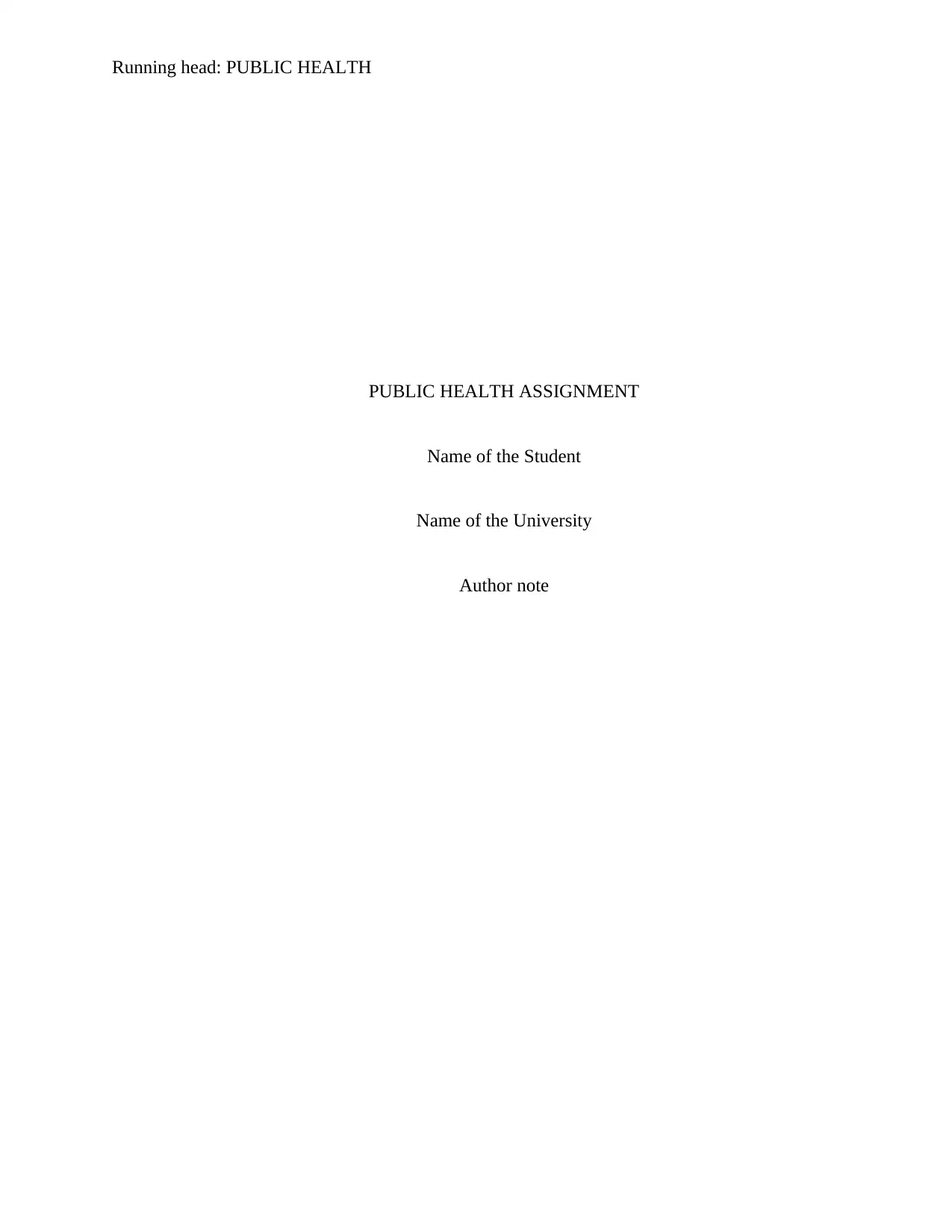
Running head: PUBLIC HEALTH
PUBLIC HEALTH ASSIGNMENT
Name of the Student
Name of the University
Author note
PUBLIC HEALTH ASSIGNMENT
Name of the Student
Name of the University
Author note
Paraphrase This Document
Need a fresh take? Get an instant paraphrase of this document with our AI Paraphraser
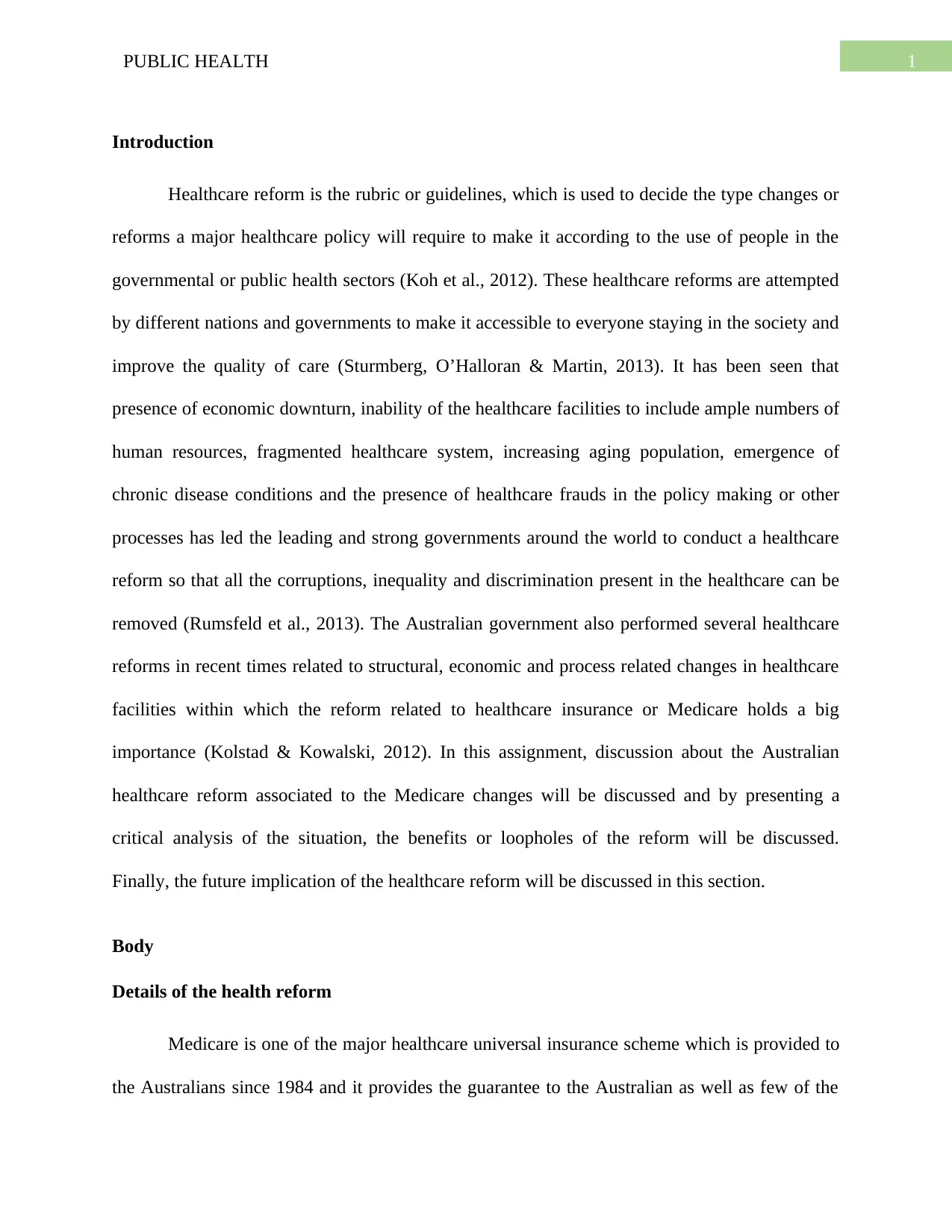
1PUBLIC HEALTH
Introduction
Healthcare reform is the rubric or guidelines, which is used to decide the type changes or
reforms a major healthcare policy will require to make it according to the use of people in the
governmental or public health sectors (Koh et al., 2012). These healthcare reforms are attempted
by different nations and governments to make it accessible to everyone staying in the society and
improve the quality of care (Sturmberg, O’Halloran & Martin, 2013). It has been seen that
presence of economic downturn, inability of the healthcare facilities to include ample numbers of
human resources, fragmented healthcare system, increasing aging population, emergence of
chronic disease conditions and the presence of healthcare frauds in the policy making or other
processes has led the leading and strong governments around the world to conduct a healthcare
reform so that all the corruptions, inequality and discrimination present in the healthcare can be
removed (Rumsfeld et al., 2013). The Australian government also performed several healthcare
reforms in recent times related to structural, economic and process related changes in healthcare
facilities within which the reform related to healthcare insurance or Medicare holds a big
importance (Kolstad & Kowalski, 2012). In this assignment, discussion about the Australian
healthcare reform associated to the Medicare changes will be discussed and by presenting a
critical analysis of the situation, the benefits or loopholes of the reform will be discussed.
Finally, the future implication of the healthcare reform will be discussed in this section.
Body
Details of the health reform
Medicare is one of the major healthcare universal insurance scheme which is provided to
the Australians since 1984 and it provides the guarantee to the Australian as well as few of the
Introduction
Healthcare reform is the rubric or guidelines, which is used to decide the type changes or
reforms a major healthcare policy will require to make it according to the use of people in the
governmental or public health sectors (Koh et al., 2012). These healthcare reforms are attempted
by different nations and governments to make it accessible to everyone staying in the society and
improve the quality of care (Sturmberg, O’Halloran & Martin, 2013). It has been seen that
presence of economic downturn, inability of the healthcare facilities to include ample numbers of
human resources, fragmented healthcare system, increasing aging population, emergence of
chronic disease conditions and the presence of healthcare frauds in the policy making or other
processes has led the leading and strong governments around the world to conduct a healthcare
reform so that all the corruptions, inequality and discrimination present in the healthcare can be
removed (Rumsfeld et al., 2013). The Australian government also performed several healthcare
reforms in recent times related to structural, economic and process related changes in healthcare
facilities within which the reform related to healthcare insurance or Medicare holds a big
importance (Kolstad & Kowalski, 2012). In this assignment, discussion about the Australian
healthcare reform associated to the Medicare changes will be discussed and by presenting a
critical analysis of the situation, the benefits or loopholes of the reform will be discussed.
Finally, the future implication of the healthcare reform will be discussed in this section.
Body
Details of the health reform
Medicare is one of the major healthcare universal insurance scheme which is provided to
the Australians since 1984 and it provides the guarantee to the Australian as well as few of the
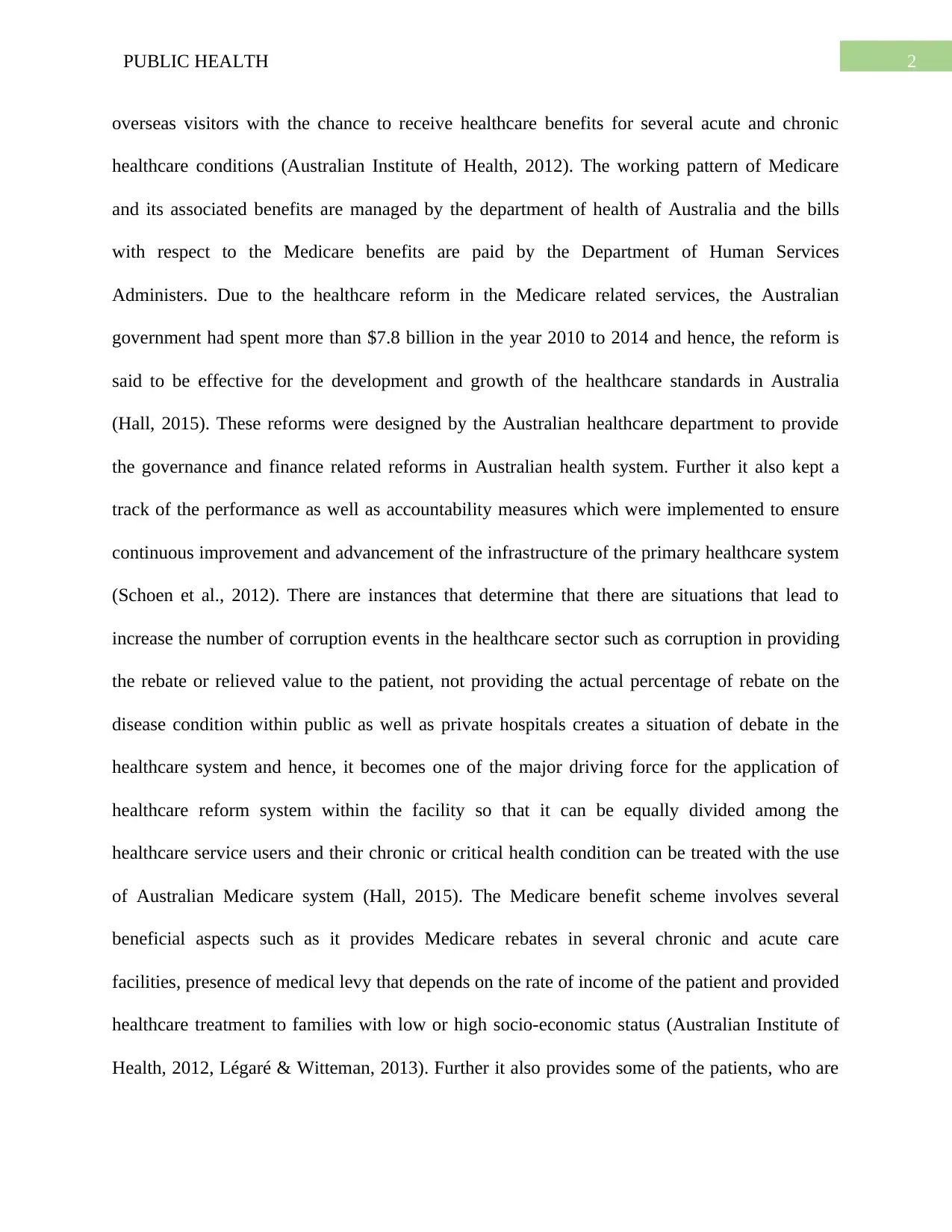
2PUBLIC HEALTH
overseas visitors with the chance to receive healthcare benefits for several acute and chronic
healthcare conditions (Australian Institute of Health, 2012). The working pattern of Medicare
and its associated benefits are managed by the department of health of Australia and the bills
with respect to the Medicare benefits are paid by the Department of Human Services
Administers. Due to the healthcare reform in the Medicare related services, the Australian
government had spent more than $7.8 billion in the year 2010 to 2014 and hence, the reform is
said to be effective for the development and growth of the healthcare standards in Australia
(Hall, 2015). These reforms were designed by the Australian healthcare department to provide
the governance and finance related reforms in Australian health system. Further it also kept a
track of the performance as well as accountability measures which were implemented to ensure
continuous improvement and advancement of the infrastructure of the primary healthcare system
(Schoen et al., 2012). There are instances that determine that there are situations that lead to
increase the number of corruption events in the healthcare sector such as corruption in providing
the rebate or relieved value to the patient, not providing the actual percentage of rebate on the
disease condition within public as well as private hospitals creates a situation of debate in the
healthcare system and hence, it becomes one of the major driving force for the application of
healthcare reform system within the facility so that it can be equally divided among the
healthcare service users and their chronic or critical health condition can be treated with the use
of Australian Medicare system (Hall, 2015). The Medicare benefit scheme involves several
beneficial aspects such as it provides Medicare rebates in several chronic and acute care
facilities, presence of medical levy that depends on the rate of income of the patient and provided
healthcare treatment to families with low or high socio-economic status (Australian Institute of
Health, 2012, Légaré & Witteman, 2013). Further it also provides some of the patients, who are
overseas visitors with the chance to receive healthcare benefits for several acute and chronic
healthcare conditions (Australian Institute of Health, 2012). The working pattern of Medicare
and its associated benefits are managed by the department of health of Australia and the bills
with respect to the Medicare benefits are paid by the Department of Human Services
Administers. Due to the healthcare reform in the Medicare related services, the Australian
government had spent more than $7.8 billion in the year 2010 to 2014 and hence, the reform is
said to be effective for the development and growth of the healthcare standards in Australia
(Hall, 2015). These reforms were designed by the Australian healthcare department to provide
the governance and finance related reforms in Australian health system. Further it also kept a
track of the performance as well as accountability measures which were implemented to ensure
continuous improvement and advancement of the infrastructure of the primary healthcare system
(Schoen et al., 2012). There are instances that determine that there are situations that lead to
increase the number of corruption events in the healthcare sector such as corruption in providing
the rebate or relieved value to the patient, not providing the actual percentage of rebate on the
disease condition within public as well as private hospitals creates a situation of debate in the
healthcare system and hence, it becomes one of the major driving force for the application of
healthcare reform system within the facility so that it can be equally divided among the
healthcare service users and their chronic or critical health condition can be treated with the use
of Australian Medicare system (Hall, 2015). The Medicare benefit scheme involves several
beneficial aspects such as it provides Medicare rebates in several chronic and acute care
facilities, presence of medical levy that depends on the rate of income of the patient and provided
healthcare treatment to families with low or high socio-economic status (Australian Institute of
Health, 2012, Légaré & Witteman, 2013). Further it also provides some of the patients, who are
⊘ This is a preview!⊘
Do you want full access?
Subscribe today to unlock all pages.

Trusted by 1+ million students worldwide
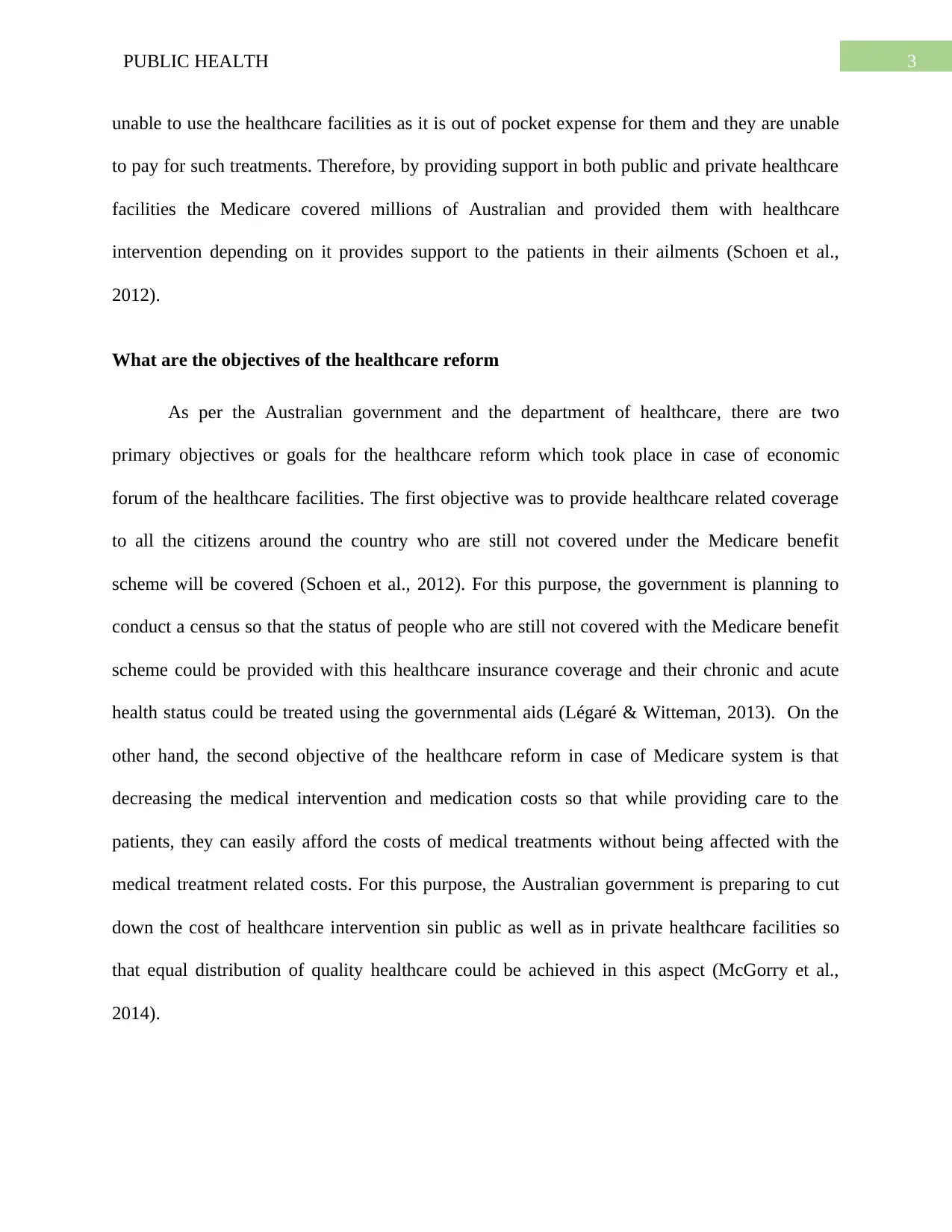
3PUBLIC HEALTH
unable to use the healthcare facilities as it is out of pocket expense for them and they are unable
to pay for such treatments. Therefore, by providing support in both public and private healthcare
facilities the Medicare covered millions of Australian and provided them with healthcare
intervention depending on it provides support to the patients in their ailments (Schoen et al.,
2012).
What are the objectives of the healthcare reform
As per the Australian government and the department of healthcare, there are two
primary objectives or goals for the healthcare reform which took place in case of economic
forum of the healthcare facilities. The first objective was to provide healthcare related coverage
to all the citizens around the country who are still not covered under the Medicare benefit
scheme will be covered (Schoen et al., 2012). For this purpose, the government is planning to
conduct a census so that the status of people who are still not covered with the Medicare benefit
scheme could be provided with this healthcare insurance coverage and their chronic and acute
health status could be treated using the governmental aids (Légaré & Witteman, 2013). On the
other hand, the second objective of the healthcare reform in case of Medicare system is that
decreasing the medical intervention and medication costs so that while providing care to the
patients, they can easily afford the costs of medical treatments without being affected with the
medical treatment related costs. For this purpose, the Australian government is preparing to cut
down the cost of healthcare intervention sin public as well as in private healthcare facilities so
that equal distribution of quality healthcare could be achieved in this aspect (McGorry et al.,
2014).
unable to use the healthcare facilities as it is out of pocket expense for them and they are unable
to pay for such treatments. Therefore, by providing support in both public and private healthcare
facilities the Medicare covered millions of Australian and provided them with healthcare
intervention depending on it provides support to the patients in their ailments (Schoen et al.,
2012).
What are the objectives of the healthcare reform
As per the Australian government and the department of healthcare, there are two
primary objectives or goals for the healthcare reform which took place in case of economic
forum of the healthcare facilities. The first objective was to provide healthcare related coverage
to all the citizens around the country who are still not covered under the Medicare benefit
scheme will be covered (Schoen et al., 2012). For this purpose, the government is planning to
conduct a census so that the status of people who are still not covered with the Medicare benefit
scheme could be provided with this healthcare insurance coverage and their chronic and acute
health status could be treated using the governmental aids (Légaré & Witteman, 2013). On the
other hand, the second objective of the healthcare reform in case of Medicare system is that
decreasing the medical intervention and medication costs so that while providing care to the
patients, they can easily afford the costs of medical treatments without being affected with the
medical treatment related costs. For this purpose, the Australian government is preparing to cut
down the cost of healthcare intervention sin public as well as in private healthcare facilities so
that equal distribution of quality healthcare could be achieved in this aspect (McGorry et al.,
2014).
Paraphrase This Document
Need a fresh take? Get an instant paraphrase of this document with our AI Paraphraser
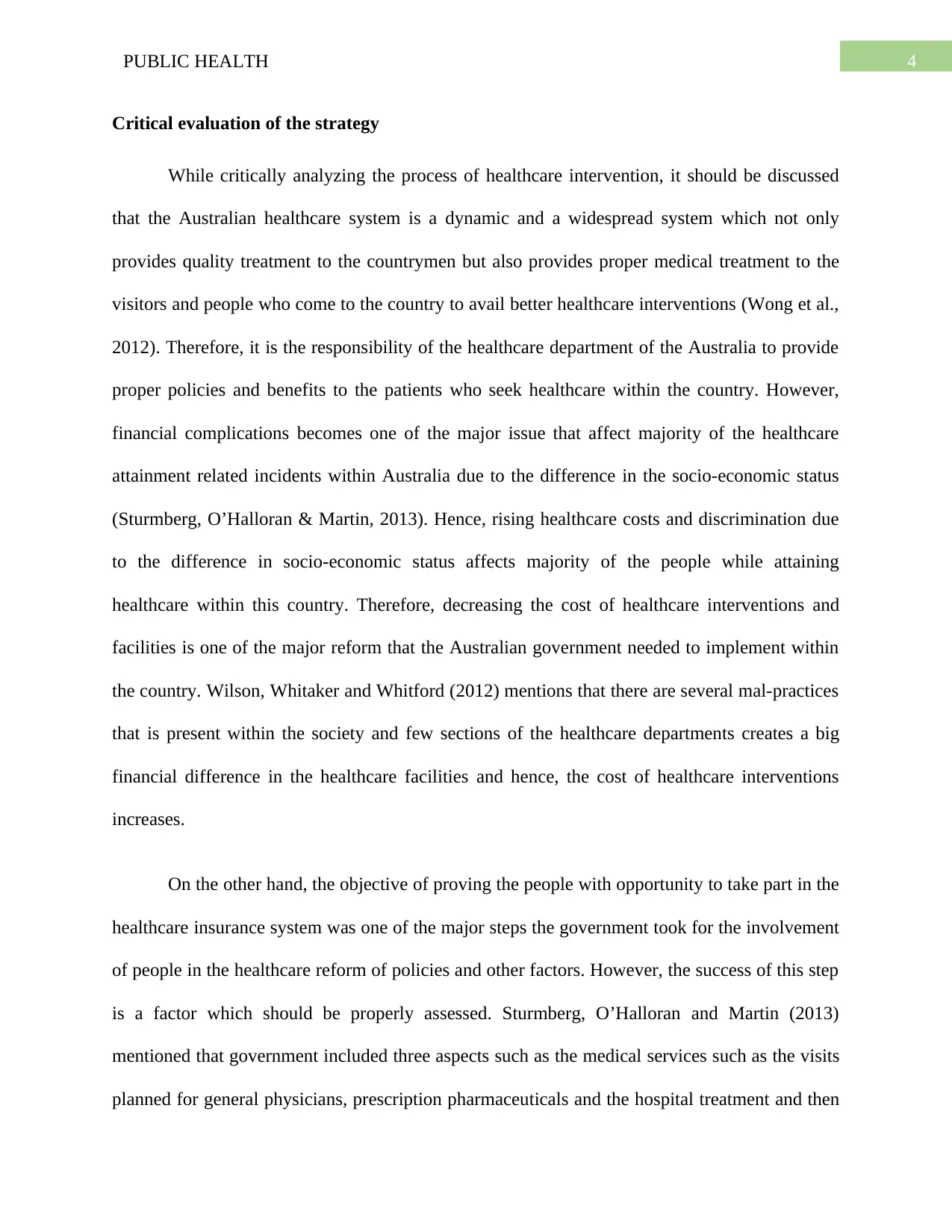
4PUBLIC HEALTH
Critical evaluation of the strategy
While critically analyzing the process of healthcare intervention, it should be discussed
that the Australian healthcare system is a dynamic and a widespread system which not only
provides quality treatment to the countrymen but also provides proper medical treatment to the
visitors and people who come to the country to avail better healthcare interventions (Wong et al.,
2012). Therefore, it is the responsibility of the healthcare department of the Australia to provide
proper policies and benefits to the patients who seek healthcare within the country. However,
financial complications becomes one of the major issue that affect majority of the healthcare
attainment related incidents within Australia due to the difference in the socio-economic status
(Sturmberg, O’Halloran & Martin, 2013). Hence, rising healthcare costs and discrimination due
to the difference in socio-economic status affects majority of the people while attaining
healthcare within this country. Therefore, decreasing the cost of healthcare interventions and
facilities is one of the major reform that the Australian government needed to implement within
the country. Wilson, Whitaker and Whitford (2012) mentions that there are several mal-practices
that is present within the society and few sections of the healthcare departments creates a big
financial difference in the healthcare facilities and hence, the cost of healthcare interventions
increases.
On the other hand, the objective of proving the people with opportunity to take part in the
healthcare insurance system was one of the major steps the government took for the involvement
of people in the healthcare reform of policies and other factors. However, the success of this step
is a factor which should be properly assessed. Sturmberg, O’Halloran and Martin (2013)
mentioned that government included three aspects such as the medical services such as the visits
planned for general physicians, prescription pharmaceuticals and the hospital treatment and then
Critical evaluation of the strategy
While critically analyzing the process of healthcare intervention, it should be discussed
that the Australian healthcare system is a dynamic and a widespread system which not only
provides quality treatment to the countrymen but also provides proper medical treatment to the
visitors and people who come to the country to avail better healthcare interventions (Wong et al.,
2012). Therefore, it is the responsibility of the healthcare department of the Australia to provide
proper policies and benefits to the patients who seek healthcare within the country. However,
financial complications becomes one of the major issue that affect majority of the healthcare
attainment related incidents within Australia due to the difference in the socio-economic status
(Sturmberg, O’Halloran & Martin, 2013). Hence, rising healthcare costs and discrimination due
to the difference in socio-economic status affects majority of the people while attaining
healthcare within this country. Therefore, decreasing the cost of healthcare interventions and
facilities is one of the major reform that the Australian government needed to implement within
the country. Wilson, Whitaker and Whitford (2012) mentions that there are several mal-practices
that is present within the society and few sections of the healthcare departments creates a big
financial difference in the healthcare facilities and hence, the cost of healthcare interventions
increases.
On the other hand, the objective of proving the people with opportunity to take part in the
healthcare insurance system was one of the major steps the government took for the involvement
of people in the healthcare reform of policies and other factors. However, the success of this step
is a factor which should be properly assessed. Sturmberg, O’Halloran and Martin (2013)
mentioned that government included three aspects such as the medical services such as the visits
planned for general physicians, prescription pharmaceuticals and the hospital treatment and then
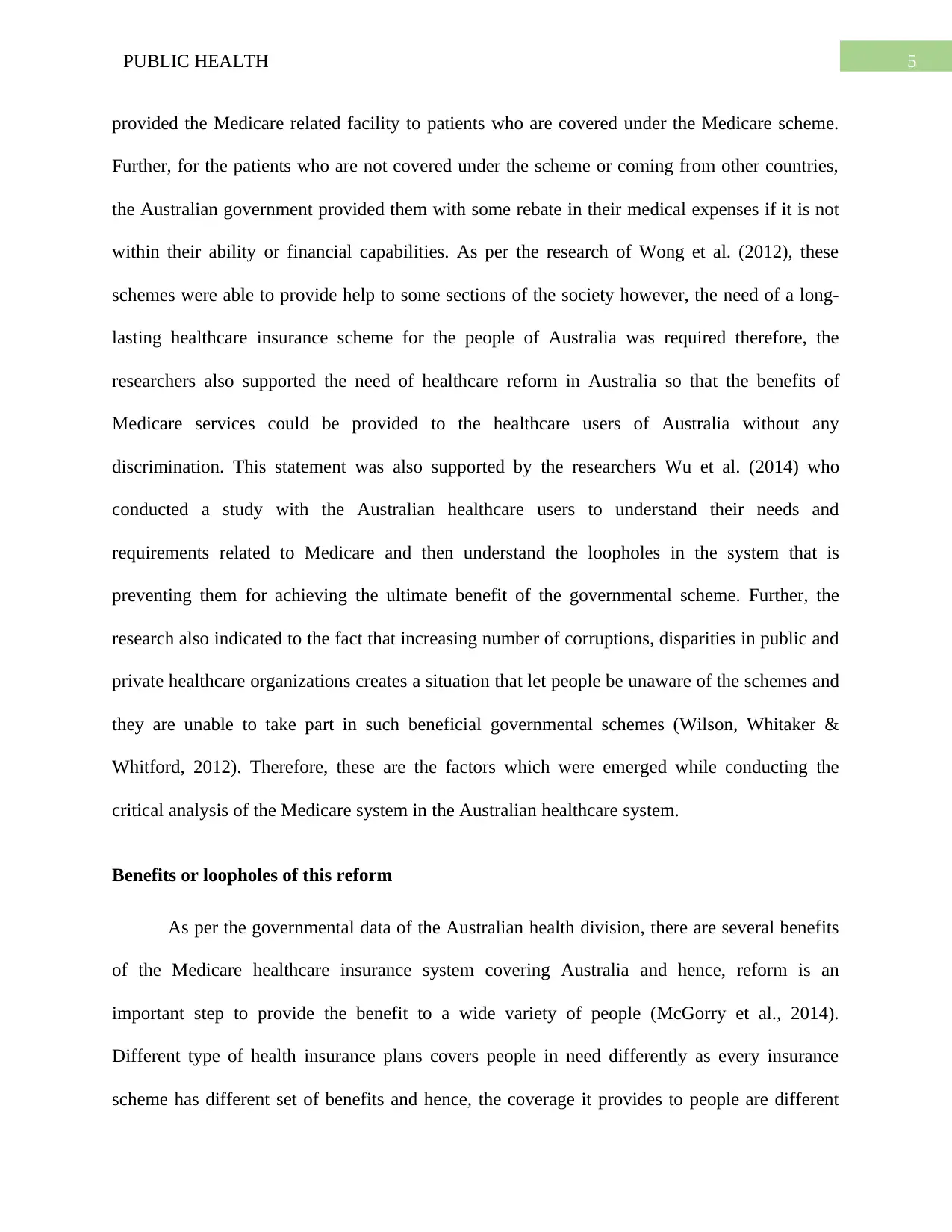
5PUBLIC HEALTH
provided the Medicare related facility to patients who are covered under the Medicare scheme.
Further, for the patients who are not covered under the scheme or coming from other countries,
the Australian government provided them with some rebate in their medical expenses if it is not
within their ability or financial capabilities. As per the research of Wong et al. (2012), these
schemes were able to provide help to some sections of the society however, the need of a long-
lasting healthcare insurance scheme for the people of Australia was required therefore, the
researchers also supported the need of healthcare reform in Australia so that the benefits of
Medicare services could be provided to the healthcare users of Australia without any
discrimination. This statement was also supported by the researchers Wu et al. (2014) who
conducted a study with the Australian healthcare users to understand their needs and
requirements related to Medicare and then understand the loopholes in the system that is
preventing them for achieving the ultimate benefit of the governmental scheme. Further, the
research also indicated to the fact that increasing number of corruptions, disparities in public and
private healthcare organizations creates a situation that let people be unaware of the schemes and
they are unable to take part in such beneficial governmental schemes (Wilson, Whitaker &
Whitford, 2012). Therefore, these are the factors which were emerged while conducting the
critical analysis of the Medicare system in the Australian healthcare system.
Benefits or loopholes of this reform
As per the governmental data of the Australian health division, there are several benefits
of the Medicare healthcare insurance system covering Australia and hence, reform is an
important step to provide the benefit to a wide variety of people (McGorry et al., 2014).
Different type of health insurance plans covers people in need differently as every insurance
scheme has different set of benefits and hence, the coverage it provides to people are different
provided the Medicare related facility to patients who are covered under the Medicare scheme.
Further, for the patients who are not covered under the scheme or coming from other countries,
the Australian government provided them with some rebate in their medical expenses if it is not
within their ability or financial capabilities. As per the research of Wong et al. (2012), these
schemes were able to provide help to some sections of the society however, the need of a long-
lasting healthcare insurance scheme for the people of Australia was required therefore, the
researchers also supported the need of healthcare reform in Australia so that the benefits of
Medicare services could be provided to the healthcare users of Australia without any
discrimination. This statement was also supported by the researchers Wu et al. (2014) who
conducted a study with the Australian healthcare users to understand their needs and
requirements related to Medicare and then understand the loopholes in the system that is
preventing them for achieving the ultimate benefit of the governmental scheme. Further, the
research also indicated to the fact that increasing number of corruptions, disparities in public and
private healthcare organizations creates a situation that let people be unaware of the schemes and
they are unable to take part in such beneficial governmental schemes (Wilson, Whitaker &
Whitford, 2012). Therefore, these are the factors which were emerged while conducting the
critical analysis of the Medicare system in the Australian healthcare system.
Benefits or loopholes of this reform
As per the governmental data of the Australian health division, there are several benefits
of the Medicare healthcare insurance system covering Australia and hence, reform is an
important step to provide the benefit to a wide variety of people (McGorry et al., 2014).
Different type of health insurance plans covers people in need differently as every insurance
scheme has different set of benefits and hence, the coverage it provides to people are different
⊘ This is a preview!⊘
Do you want full access?
Subscribe today to unlock all pages.

Trusted by 1+ million students worldwide
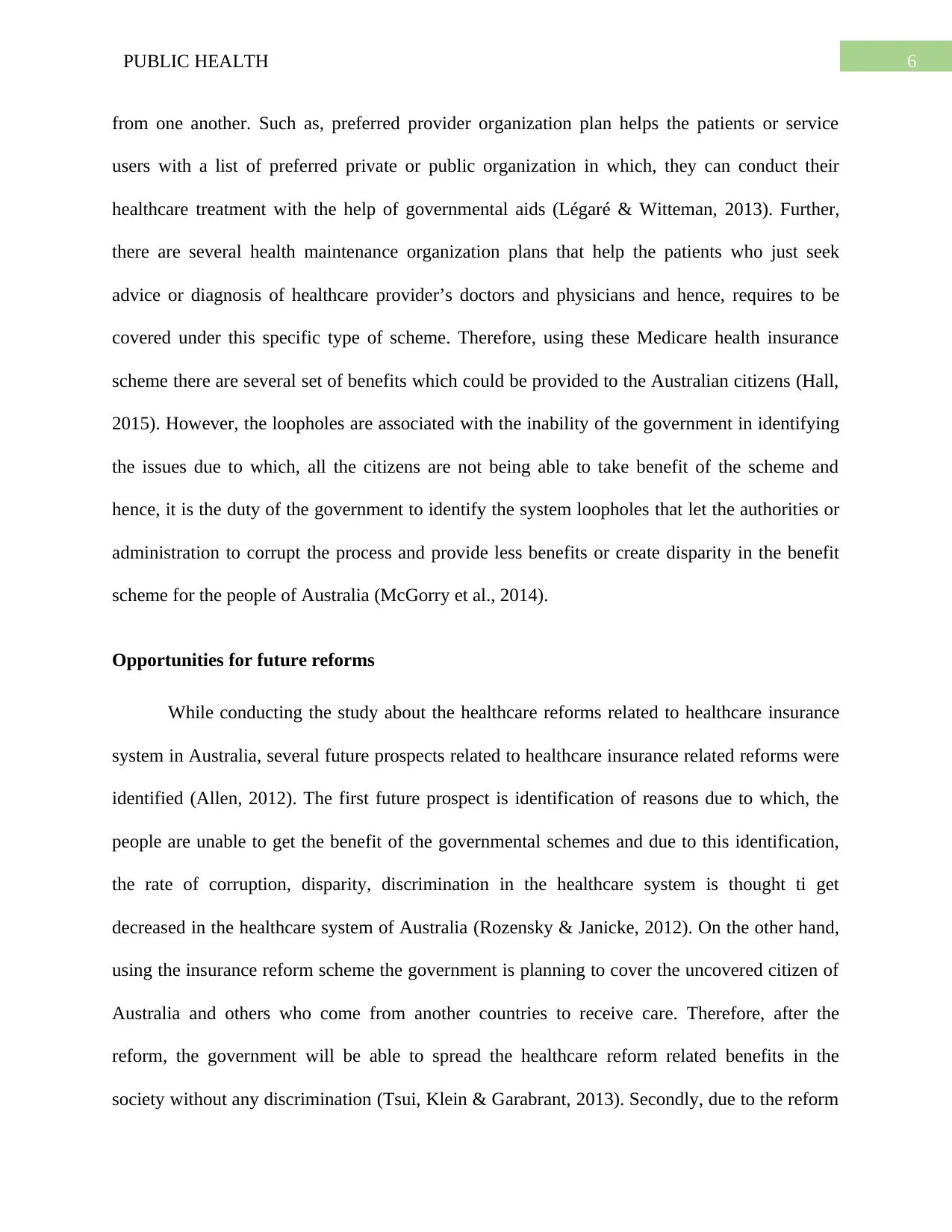
6PUBLIC HEALTH
from one another. Such as, preferred provider organization plan helps the patients or service
users with a list of preferred private or public organization in which, they can conduct their
healthcare treatment with the help of governmental aids (Légaré & Witteman, 2013). Further,
there are several health maintenance organization plans that help the patients who just seek
advice or diagnosis of healthcare provider’s doctors and physicians and hence, requires to be
covered under this specific type of scheme. Therefore, using these Medicare health insurance
scheme there are several set of benefits which could be provided to the Australian citizens (Hall,
2015). However, the loopholes are associated with the inability of the government in identifying
the issues due to which, all the citizens are not being able to take benefit of the scheme and
hence, it is the duty of the government to identify the system loopholes that let the authorities or
administration to corrupt the process and provide less benefits or create disparity in the benefit
scheme for the people of Australia (McGorry et al., 2014).
Opportunities for future reforms
While conducting the study about the healthcare reforms related to healthcare insurance
system in Australia, several future prospects related to healthcare insurance related reforms were
identified (Allen, 2012). The first future prospect is identification of reasons due to which, the
people are unable to get the benefit of the governmental schemes and due to this identification,
the rate of corruption, disparity, discrimination in the healthcare system is thought ti get
decreased in the healthcare system of Australia (Rozensky & Janicke, 2012). On the other hand,
using the insurance reform scheme the government is planning to cover the uncovered citizen of
Australia and others who come from another countries to receive care. Therefore, after the
reform, the government will be able to spread the healthcare reform related benefits in the
society without any discrimination (Tsui, Klein & Garabrant, 2013). Secondly, due to the reform
from one another. Such as, preferred provider organization plan helps the patients or service
users with a list of preferred private or public organization in which, they can conduct their
healthcare treatment with the help of governmental aids (Légaré & Witteman, 2013). Further,
there are several health maintenance organization plans that help the patients who just seek
advice or diagnosis of healthcare provider’s doctors and physicians and hence, requires to be
covered under this specific type of scheme. Therefore, using these Medicare health insurance
scheme there are several set of benefits which could be provided to the Australian citizens (Hall,
2015). However, the loopholes are associated with the inability of the government in identifying
the issues due to which, all the citizens are not being able to take benefit of the scheme and
hence, it is the duty of the government to identify the system loopholes that let the authorities or
administration to corrupt the process and provide less benefits or create disparity in the benefit
scheme for the people of Australia (McGorry et al., 2014).
Opportunities for future reforms
While conducting the study about the healthcare reforms related to healthcare insurance
system in Australia, several future prospects related to healthcare insurance related reforms were
identified (Allen, 2012). The first future prospect is identification of reasons due to which, the
people are unable to get the benefit of the governmental schemes and due to this identification,
the rate of corruption, disparity, discrimination in the healthcare system is thought ti get
decreased in the healthcare system of Australia (Rozensky & Janicke, 2012). On the other hand,
using the insurance reform scheme the government is planning to cover the uncovered citizen of
Australia and others who come from another countries to receive care. Therefore, after the
reform, the government will be able to spread the healthcare reform related benefits in the
society without any discrimination (Tsui, Klein & Garabrant, 2013). Secondly, due to the reform
Paraphrase This Document
Need a fresh take? Get an instant paraphrase of this document with our AI Paraphraser
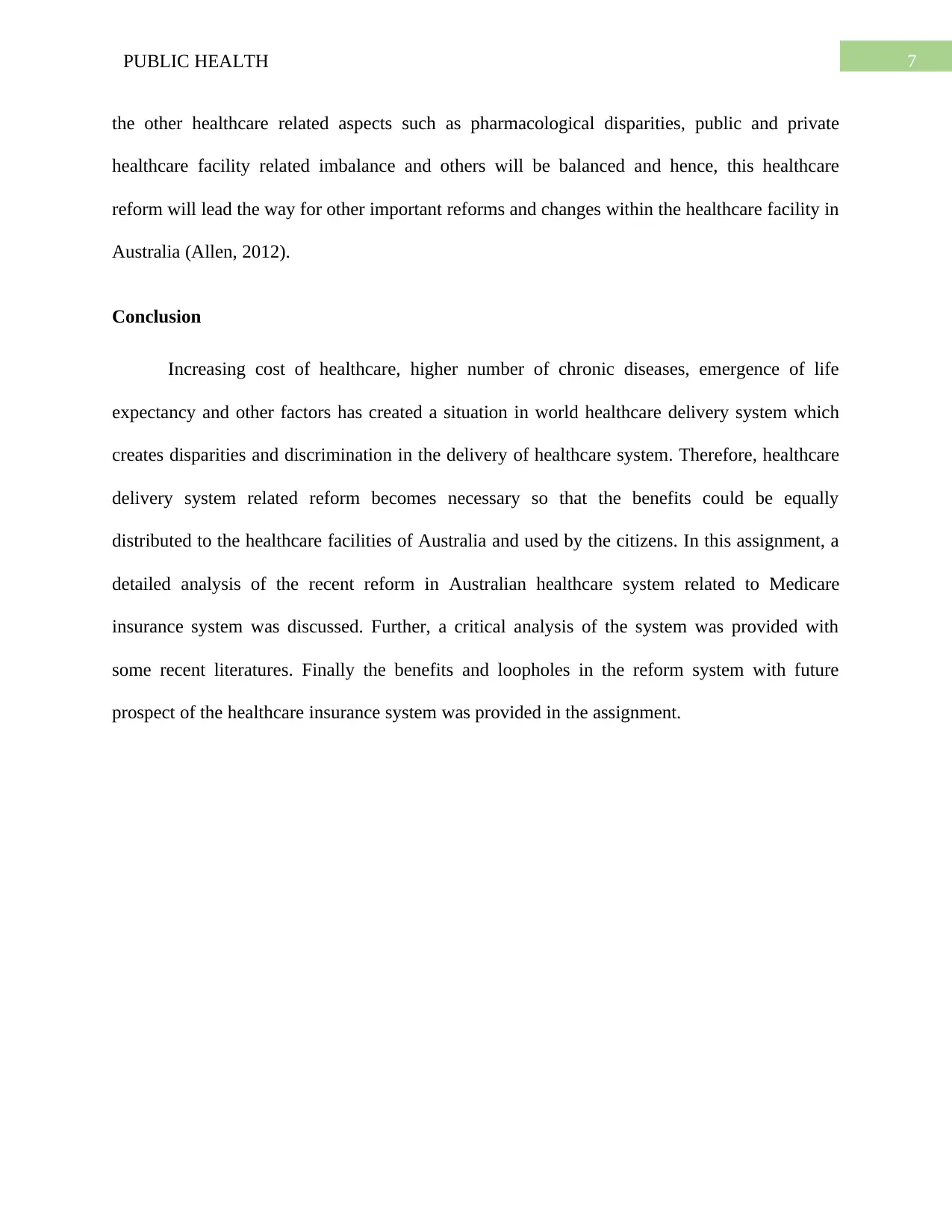
7PUBLIC HEALTH
the other healthcare related aspects such as pharmacological disparities, public and private
healthcare facility related imbalance and others will be balanced and hence, this healthcare
reform will lead the way for other important reforms and changes within the healthcare facility in
Australia (Allen, 2012).
Conclusion
Increasing cost of healthcare, higher number of chronic diseases, emergence of life
expectancy and other factors has created a situation in world healthcare delivery system which
creates disparities and discrimination in the delivery of healthcare system. Therefore, healthcare
delivery system related reform becomes necessary so that the benefits could be equally
distributed to the healthcare facilities of Australia and used by the citizens. In this assignment, a
detailed analysis of the recent reform in Australian healthcare system related to Medicare
insurance system was discussed. Further, a critical analysis of the system was provided with
some recent literatures. Finally the benefits and loopholes in the reform system with future
prospect of the healthcare insurance system was provided in the assignment.
the other healthcare related aspects such as pharmacological disparities, public and private
healthcare facility related imbalance and others will be balanced and hence, this healthcare
reform will lead the way for other important reforms and changes within the healthcare facility in
Australia (Allen, 2012).
Conclusion
Increasing cost of healthcare, higher number of chronic diseases, emergence of life
expectancy and other factors has created a situation in world healthcare delivery system which
creates disparities and discrimination in the delivery of healthcare system. Therefore, healthcare
delivery system related reform becomes necessary so that the benefits could be equally
distributed to the healthcare facilities of Australia and used by the citizens. In this assignment, a
detailed analysis of the recent reform in Australian healthcare system related to Medicare
insurance system was discussed. Further, a critical analysis of the system was provided with
some recent literatures. Finally the benefits and loopholes in the reform system with future
prospect of the healthcare insurance system was provided in the assignment.
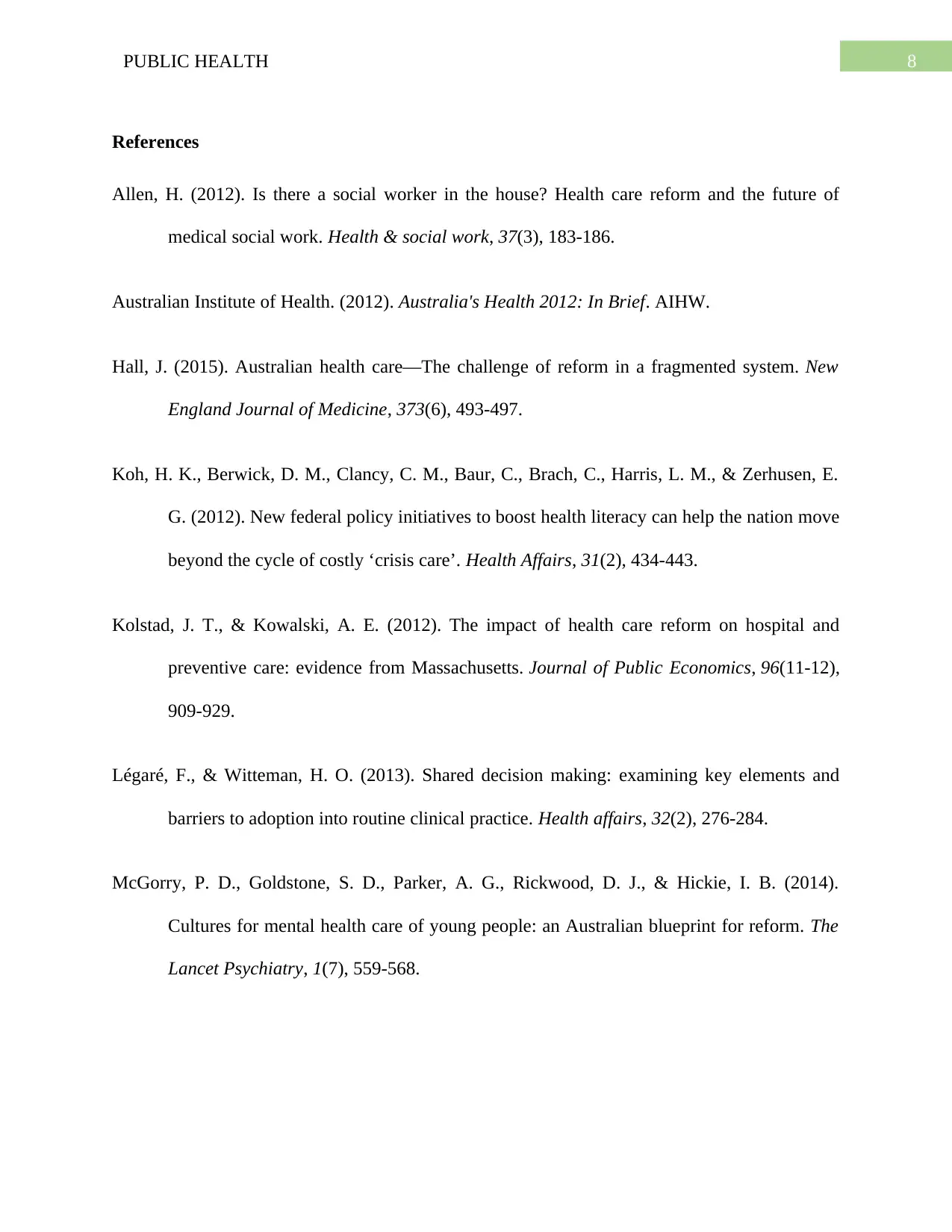
8PUBLIC HEALTH
References
Allen, H. (2012). Is there a social worker in the house? Health care reform and the future of
medical social work. Health & social work, 37(3), 183-186.
Australian Institute of Health. (2012). Australia's Health 2012: In Brief. AIHW.
Hall, J. (2015). Australian health care—The challenge of reform in a fragmented system. New
England Journal of Medicine, 373(6), 493-497.
Koh, H. K., Berwick, D. M., Clancy, C. M., Baur, C., Brach, C., Harris, L. M., & Zerhusen, E.
G. (2012). New federal policy initiatives to boost health literacy can help the nation move
beyond the cycle of costly ‘crisis care’. Health Affairs, 31(2), 434-443.
Kolstad, J. T., & Kowalski, A. E. (2012). The impact of health care reform on hospital and
preventive care: evidence from Massachusetts. Journal of Public Economics, 96(11-12),
909-929.
Légaré, F., & Witteman, H. O. (2013). Shared decision making: examining key elements and
barriers to adoption into routine clinical practice. Health affairs, 32(2), 276-284.
McGorry, P. D., Goldstone, S. D., Parker, A. G., Rickwood, D. J., & Hickie, I. B. (2014).
Cultures for mental health care of young people: an Australian blueprint for reform. The
Lancet Psychiatry, 1(7), 559-568.
References
Allen, H. (2012). Is there a social worker in the house? Health care reform and the future of
medical social work. Health & social work, 37(3), 183-186.
Australian Institute of Health. (2012). Australia's Health 2012: In Brief. AIHW.
Hall, J. (2015). Australian health care—The challenge of reform in a fragmented system. New
England Journal of Medicine, 373(6), 493-497.
Koh, H. K., Berwick, D. M., Clancy, C. M., Baur, C., Brach, C., Harris, L. M., & Zerhusen, E.
G. (2012). New federal policy initiatives to boost health literacy can help the nation move
beyond the cycle of costly ‘crisis care’. Health Affairs, 31(2), 434-443.
Kolstad, J. T., & Kowalski, A. E. (2012). The impact of health care reform on hospital and
preventive care: evidence from Massachusetts. Journal of Public Economics, 96(11-12),
909-929.
Légaré, F., & Witteman, H. O. (2013). Shared decision making: examining key elements and
barriers to adoption into routine clinical practice. Health affairs, 32(2), 276-284.
McGorry, P. D., Goldstone, S. D., Parker, A. G., Rickwood, D. J., & Hickie, I. B. (2014).
Cultures for mental health care of young people: an Australian blueprint for reform. The
Lancet Psychiatry, 1(7), 559-568.
⊘ This is a preview!⊘
Do you want full access?
Subscribe today to unlock all pages.

Trusted by 1+ million students worldwide
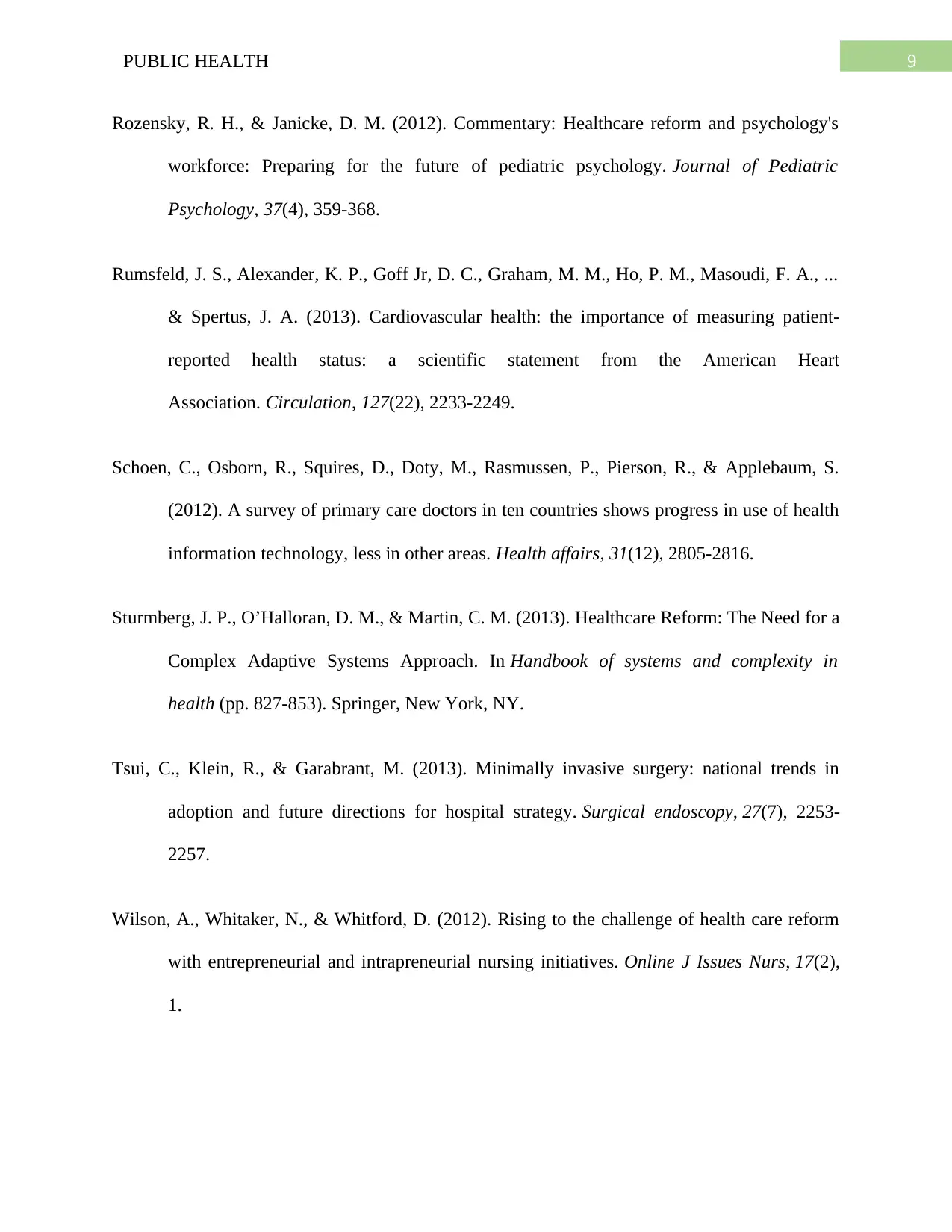
9PUBLIC HEALTH
Rozensky, R. H., & Janicke, D. M. (2012). Commentary: Healthcare reform and psychology's
workforce: Preparing for the future of pediatric psychology. Journal of Pediatric
Psychology, 37(4), 359-368.
Rumsfeld, J. S., Alexander, K. P., Goff Jr, D. C., Graham, M. M., Ho, P. M., Masoudi, F. A., ...
& Spertus, J. A. (2013). Cardiovascular health: the importance of measuring patient-
reported health status: a scientific statement from the American Heart
Association. Circulation, 127(22), 2233-2249.
Schoen, C., Osborn, R., Squires, D., Doty, M., Rasmussen, P., Pierson, R., & Applebaum, S.
(2012). A survey of primary care doctors in ten countries shows progress in use of health
information technology, less in other areas. Health affairs, 31(12), 2805-2816.
Sturmberg, J. P., O’Halloran, D. M., & Martin, C. M. (2013). Healthcare Reform: The Need for a
Complex Adaptive Systems Approach. In Handbook of systems and complexity in
health (pp. 827-853). Springer, New York, NY.
Tsui, C., Klein, R., & Garabrant, M. (2013). Minimally invasive surgery: national trends in
adoption and future directions for hospital strategy. Surgical endoscopy, 27(7), 2253-
2257.
Wilson, A., Whitaker, N., & Whitford, D. (2012). Rising to the challenge of health care reform
with entrepreneurial and intrapreneurial nursing initiatives. Online J Issues Nurs, 17(2),
1.
Rozensky, R. H., & Janicke, D. M. (2012). Commentary: Healthcare reform and psychology's
workforce: Preparing for the future of pediatric psychology. Journal of Pediatric
Psychology, 37(4), 359-368.
Rumsfeld, J. S., Alexander, K. P., Goff Jr, D. C., Graham, M. M., Ho, P. M., Masoudi, F. A., ...
& Spertus, J. A. (2013). Cardiovascular health: the importance of measuring patient-
reported health status: a scientific statement from the American Heart
Association. Circulation, 127(22), 2233-2249.
Schoen, C., Osborn, R., Squires, D., Doty, M., Rasmussen, P., Pierson, R., & Applebaum, S.
(2012). A survey of primary care doctors in ten countries shows progress in use of health
information technology, less in other areas. Health affairs, 31(12), 2805-2816.
Sturmberg, J. P., O’Halloran, D. M., & Martin, C. M. (2013). Healthcare Reform: The Need for a
Complex Adaptive Systems Approach. In Handbook of systems and complexity in
health (pp. 827-853). Springer, New York, NY.
Tsui, C., Klein, R., & Garabrant, M. (2013). Minimally invasive surgery: national trends in
adoption and future directions for hospital strategy. Surgical endoscopy, 27(7), 2253-
2257.
Wilson, A., Whitaker, N., & Whitford, D. (2012). Rising to the challenge of health care reform
with entrepreneurial and intrapreneurial nursing initiatives. Online J Issues Nurs, 17(2),
1.
Paraphrase This Document
Need a fresh take? Get an instant paraphrase of this document with our AI Paraphraser
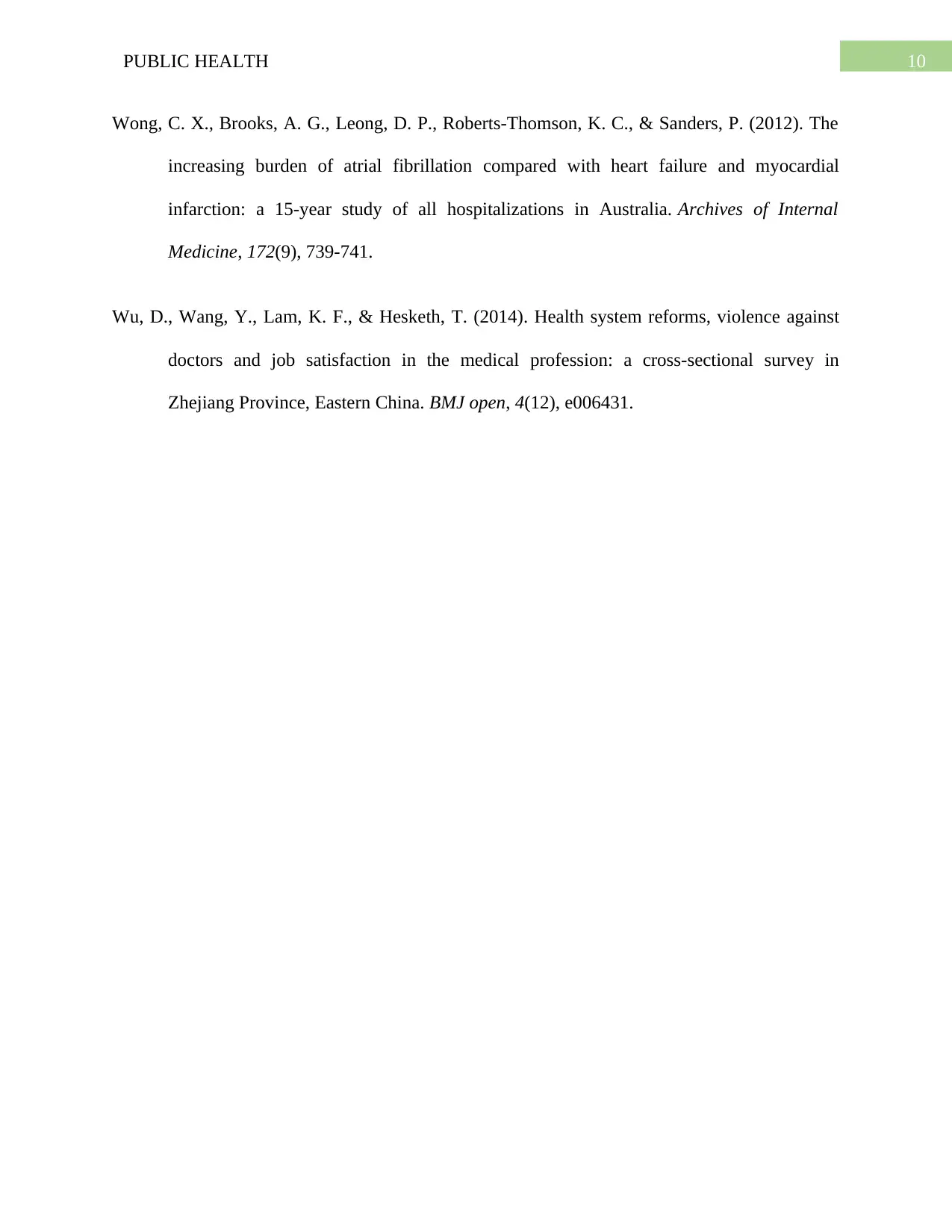
10PUBLIC HEALTH
Wong, C. X., Brooks, A. G., Leong, D. P., Roberts-Thomson, K. C., & Sanders, P. (2012). The
increasing burden of atrial fibrillation compared with heart failure and myocardial
infarction: a 15-year study of all hospitalizations in Australia. Archives of Internal
Medicine, 172(9), 739-741.
Wu, D., Wang, Y., Lam, K. F., & Hesketh, T. (2014). Health system reforms, violence against
doctors and job satisfaction in the medical profession: a cross-sectional survey in
Zhejiang Province, Eastern China. BMJ open, 4(12), e006431.
Wong, C. X., Brooks, A. G., Leong, D. P., Roberts-Thomson, K. C., & Sanders, P. (2012). The
increasing burden of atrial fibrillation compared with heart failure and myocardial
infarction: a 15-year study of all hospitalizations in Australia. Archives of Internal
Medicine, 172(9), 739-741.
Wu, D., Wang, Y., Lam, K. F., & Hesketh, T. (2014). Health system reforms, violence against
doctors and job satisfaction in the medical profession: a cross-sectional survey in
Zhejiang Province, Eastern China. BMJ open, 4(12), e006431.
1 out of 11
Related Documents
Your All-in-One AI-Powered Toolkit for Academic Success.
+13062052269
info@desklib.com
Available 24*7 on WhatsApp / Email
![[object Object]](/_next/static/media/star-bottom.7253800d.svg)
Unlock your academic potential
Copyright © 2020–2025 A2Z Services. All Rights Reserved. Developed and managed by ZUCOL.





